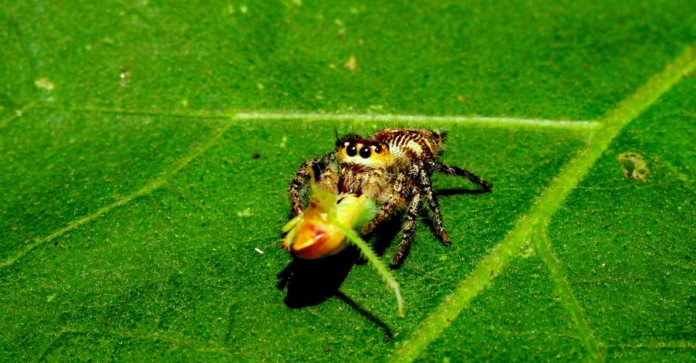
It has long been suspected that eight-legged carnivores, spiders are one of the most important groups of voracious predators of insects. Each year, spiders consume a lot. In fact, they eat more prey annually than humans do. You might be surprised to know that about 27 million tons of spiders, consume somewhere between 440 million and 880 million tons of insects, springtails, and other invertebrates each year, equal to the weight of more than 85 million elephants, a team of Swiss and Swedish zoologists has calculated. Yes, that’s a lot of bugs.
The new study, published in the scientific journal “The Science of Nature,” found an estimated 27 million tons of spiders are responsible for killing astronomical numbers of insects on a global scale, making them a major natural enemy to insect populations.

There are more than seven billion humans on the planet. For comparison, all humans in the world eat about 440 million tons (400 million metric tons) of meat and fish every year, according to the United Nations Food and Agriculture Organisation – meaning our eight-legged carnivore friends likely have us beat when it comes to meat-eating. The finding estimates that the amount of food that spiders ingest annually can also be compared to the volume of food that all whale species (Cetacea) consume each year, a number that stands between 300 million and 550 million tons (280 million and 500 million metric tons) of food.
“Our estimates for spiders appear to be of the same order of magnitude as the prey killed by whales in the world’s oceans which has been estimated to be in the range of 280-500 million tons annually,” wrote the authors in The Science of Nature.
Spiders massacre 400 – 800 million tonnes of animal prey per year https://t.co/DUE7YZTtK9 pic.twitter.com/uOV6loCh0f
— AFP news agency (@AFP) March 15, 2017
This is according to the findings of Martin Nyffeler, an expert on the ecological impact of spider predation, from the University of Basel in Switzerland and ecologist Klaus Birkhofer of Lund University in Sweden and the Brandenburg University of Technology Cottbus-Senftenberg in Germany, published in Springer’s journal The Science of Nature. “By contrast, the annual food consumption of all the world’s seabirds is estimated at 70 million tons,” the researchers wrote.
To estimate spider biomass (essentially, the total weight of all the spiders on the globe), the researchers evaluated spiders from seven terrestrial biomes: tropical forests, temperate and boreal forests, tropical grasslands and savannas, temperate grasslands and Mediterranean shrublands, annual cropland, deserts and Arctic tundra. In the process, most of them are found especially in forests and grassland areas. And these eight-legged carnivores’ ravenous appetite keeps countless insect pests in check.
There are more than 45,000 species of the eight-legged creatures living in all parts of the world and according to the Live Science, researchers estimate that there are around 131 spiders per every square meter of land on the globe, and in some places a population density of up to 1,000 individuals per square meter. Spiders are estimated to weight of about 25 million metric tons (about 27 million U.S. tons) in total biomass, which means that weight for weight, the Arachnid group as a whole consumes 16-32 times its biomass each year. They are one of the world’s most species-rich and widespread groups of predators.

Spiders are beneficial in keeping insect populations down and they also serve to protect plants and trees by eating the bugs that could be food for invasive insects, according to study lead author Martin Nyffeler of the University of Basel in Switzerland.
“Our calculations let us quantify for the first time on a global scale that spiders are major natural enemies of insects. In concert with other insectivorous animals such as ants and birds, they help to reduce the population densities of insects significantly. Spiders thus make an essential contribution to maintaining the ecological balance of nature,” Nyffeler said, USA Today reported.
With a few rare exceptions, spiders are carnivores, besides insects, larger species of spiders can also eat frogs, lizards, snakes, fish, birds, and bats. It is hard to directly measure their impact on their prey due to their secretive lifestyle – many spiders are nocturnal or live well camouflaged in vegetation that was previously difficult to demonstrate their ecological role. To estimate how much spiders, eat, then, the zoologists at the University of Basel and Lund University (Sweden) had to start calculations by figuring out how much spider tonnage is out there.

Once they estimated the spider’s biomass, Nyffeler and Birkhofer then used two simple models to calculate the amount of food that the world’s spiders consume yearly.
The first method was calculating how much food a spider generally needs to eat to survive, depending on its body mass. For most spiders, they estimate that the number stands at 0.1 milligrams of food per milligram of spider, or about 10 percent of the spider’s body weight on a daily basis. For desert spiders, the number stands between 0.01 and 0.04 milligrams of food per milligram of a spider, because they have evolved to survive under difficult circumstances. Researchers were able to estimate a range of food varying from 507 million to 772 million U.S tons (460 million and 700 million metric tons of prey per year).
The second method was based on prey capture (based on observations) in the field, then the researchers combined it with estimate numbers of spider per square meter. According to extrapolating data from researchers on the field, 435 million and 887 million U.S. tons (395 million and 805 million metric tons) of prey are being killed by spiders each year.

The researchers found that insects and springtails (collembolans), like fleas, make up about 90 percent of spiders’ prey. And the other 10 percent, which is associated with larger species of spiders, they eat worms and small vertebrates like birds, bats or mice, and even snakes.
The study also shows that the forest and grassland spiders are responsible for 95 percent of the prey kill each year. The figure reflects the fact that forests, grasslands and savannas have more ground to cover and their habitats are not frequently disturbed by humans. In turn, spiders living in agricultural fields or urban areas, for example, have to contend with pesticides and human activities, they only make up for less than 2 percent of the annual prey kill.
“These estimates emphasize the important role that spider predation plays in semi-natural and natural habitats, as many economically important pests and disease vectors breed in those forest and grassland biomes,” the researchers wrote.
It’s impossible to determine how many individual insects it takes to get to 800 million U.S. tons or how many spiders are required to put together weigh 27 million tons, Nyffeler, a senior lecturer in biology, told Live Science. It’s hard to say the estimates number of spiders in the world because there is too much variation, he said.

A British arachnologist speculated in 1947 that there were approximately 2.2 trillion spiders in England and Wales alone, Nyffeler told LiveScience.
According to the researchers, spiders are not only important predators, but are also valuable sources of prey. Between 8,000 and 10,000 other predators, parasites and parasitoids feed exclusively on spiders, while spiders at the same time are also an important part of the diet of an estimated 3,000 to 5,000 bird species.
“We hope that these estimates and their significant magnitude raise public awareness and increase the level of appreciation for the important global role of spiders in terrestrial food webs,” Nyffeler added.
Story Source: Live Science
The findings are reported in The Science of Nature.



























